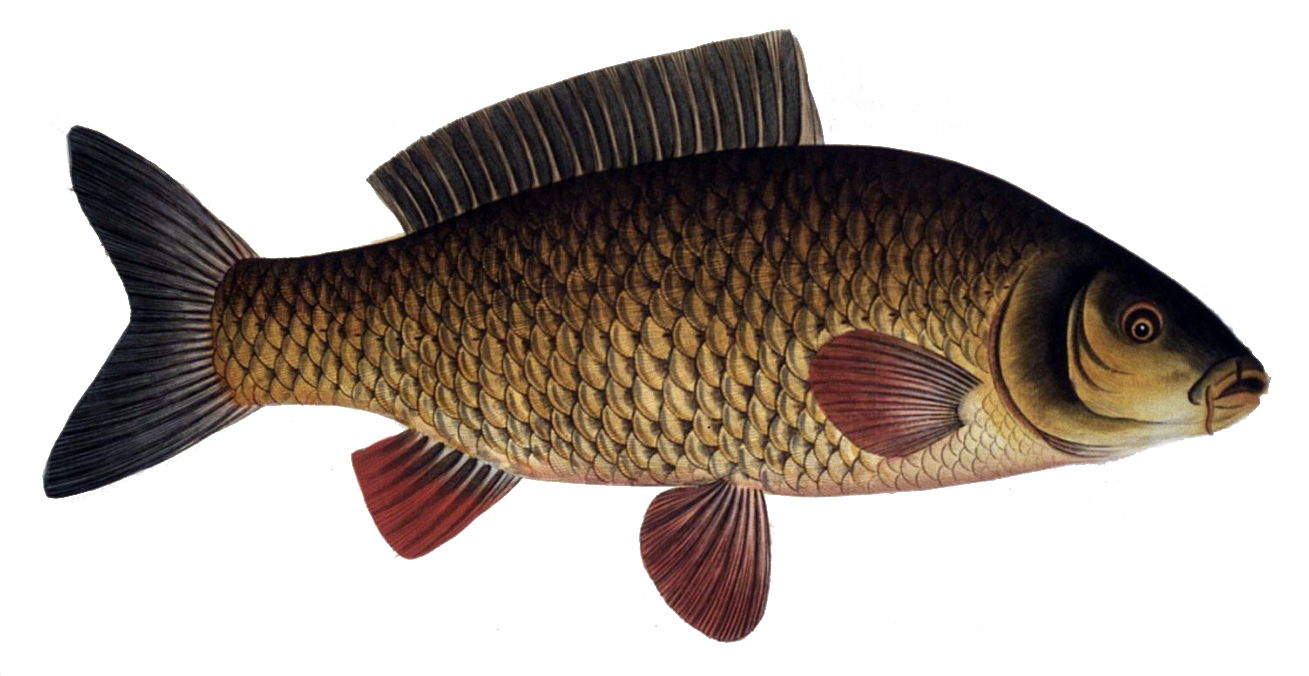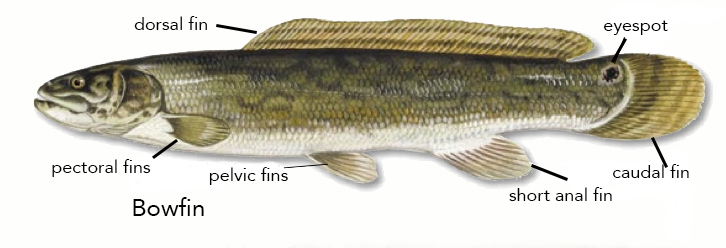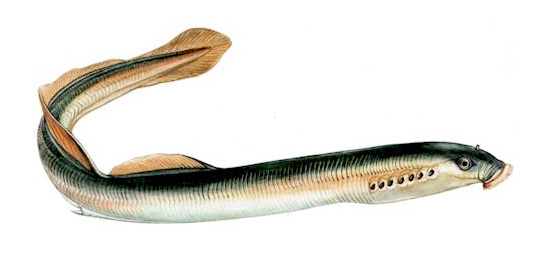|
Halecomorphi
Halecomorphi is a taxon of ray-finned bony fish in the clade Neopterygii. The sole living Halecomorph is the bowfin (''Amia calva''), but the group contains many extinct species in several families (including Amiidae, Caturidae, Liodesmidae, Sinamiidae) in the order Amiiformes, as well as the extinct orders Ionoscopiformes, Panxianichthyiformes, and Parasemionotiformes. The fossil record of halecomorphs goes back at least to the Early Triassic epoch. The Halecomorphi exhibit a combination of ancestral features, such as most heavily mineralized scales, but also by more derived or "modern" features, particularly in the structure of the skull (e.g. position and shape of preopercles). Unique derived traits (synapomorphies) of the Halecomorphi include: *Unique jaw articulation in which the quadrate and symplectic participate in the joint. *Lengthened dorsal fins (in some species) *Two biconcave vertebrae per segment in the posterior body region (a condition known as dip ... [...More Info...] [...Related Items...] OR: [Wikipedia] [Google] [Baidu] |
Parasemionotiformes
Parasemionotiformes is an extinct order of neopterygian ray-finned fish that existed globally during the Triassic period. It comprises the families Parasemionotidae and Promecosominidae. Many of the included genera are monotypic and most species lived during the Early Triassic epoch.Romano et al. (2016): Marine Early Triassic Osteichthyes from Spiti, Indian Himalayas. Swiss Journal of Palaeontology 135: 275-294 https://doi.org/10.1007/s13358-015-0098-6 Parasemionotiforms were normally small to medium-sized fishes. They were predominantly marine. Evolutionary relationships Parasemionotiformes are neopterygians, which is the clade that encompasses the vast majority of living ray-finned fishes (Actinopterygii) and about half of all living species of vertebrates. Neopterygii are divided into Teleostei and Holostei. The latter represents a depauperate group today but used to be a diverse clade especially during the Mesozoic Era. The only surviving members of the Holostei are the g ... [...More Info...] [...Related Items...] OR: [Wikipedia] [Google] [Baidu] |
Amiiformes
The Amiiformes order of fish has only one extant species, the bowfin (''Amia calva''). These Amiiformes are found in the freshwater systems of North America, in the United States and parts of southern Canada. They live in freshwater streams, rivers, and swamps. Bowfins are not on the endangered list. They have the ability to go to the surface to breathe air if the water level is too low. Characteristics of Amiiformes are a cylindrical body with a long dorsal fin, single gular plate, heterocercal caudal fin, 10 to 13 flattened branchiostegal rays, maxilla included in gape, and prominent ocellus near upper base of caudal fin. Evolution and diversity The extinct species of the Amiiformes can be found as fossils in Asia and Europe, but the bowfin is the last living species in the order. Amiiformes is therefore the last surviving order of Halecomorphi, the clade to which the bowfin and its fossil relatives belong. Other orders, such as the Parasemionotiformes, are all extinct. H ... [...More Info...] [...Related Items...] OR: [Wikipedia] [Google] [Baidu] |
Cipactlichthys Scutatus
''Cipactlichthys'' is a genus of extinct holostean fish from the Lower Cretaceous of Mexico. The only known species is ''Cipactlichthys scutatus''. Discovery and etymology ''Cipactlichthys scutatus'' is known from two fossils discovered in the Tlayua Formation near the town of Tepexi de Rodríguez, in Puebla, Mexico. The Tlayua Formation, is Albian (Early Cretaceous) in age, interpreted as an epicontinental marine deposit. Due to its high quality preservation and abundance of fish fossils, the formation is considered one of the most important sources of Cretaceous fishes in Mexico. The genus name is a combination of ''Cipactli'', the Aztec mythological sea monster said to be part fish and part reptile, and ''ichthys'', Greek for "fish". The specific epithet ''scutatus'' is Latin for shield, referring to the large dorsal and ventral scutes. Description ''Cipactlichthys'' is an elongate fish, approximately 130 mm in total length, or 100 mm in standard length. I ... [...More Info...] [...Related Items...] OR: [Wikipedia] [Google] [Baidu] |
Amia Calva
The bowfin (''Amia calva'') is a bony fish, native to North America. Common names include mudfish, mud pike, dogfish, grindle, grinnel, swamp trout, and choupique. It is regarded as a relict, being the sole surviving species of the Halecomorphi, a group of fish that first appeared during the Early Triassic, around 250 million years ago. The bowfin is often considered a " primitive fish" because they have retained some morphological characteristics of their early ancestors. The closest living relatives of bowfins are gars, with the two groups being united in the clade Holostei. Bowfins are demersal freshwater piscivores, commonly found throughout much of the eastern United States, and in southern Ontario and Quebec. Fossil deposits indicate Amiiformes were once widespread in both freshwater and marine environments across North and South America, Europe, Asia, and Africa. Now, their range is limited to much of the eastern United States and adjacent southern Canada, including ... [...More Info...] [...Related Items...] OR: [Wikipedia] [Google] [Baidu] |
Neopterygii
Neopterygii (from Greek νέος ''neos'' 'new' and πτέρυξ ''pteryx'' 'fin') is a subclass of ray-finned fish (Actinopterygii). Neopterygii includes the Holostei and the Teleostei, of which the latter comprise the vast majority of extant fishes, and over half of all living vertebrate species. While living holosteans include only freshwater taxa, teleosts are diverse in both freshwater and marine environments. Many new species of teleosts are scientifically described each year. Fossil evidence for crown group neopterygians goes back at least 251 million years to the Induan stage of the Early Triassic epoch, however, one study incorporating morphological data from fossils and molecular data from nuclear and mitochondrial DNA, places this divergence date at least 284 mya (million years ago), during the Artinskian stage of the Early Permian. Another study suggests an even earlier split (360 myr ago, near the Devonian-Carboniferous boundary). Evolution and diversity L ... [...More Info...] [...Related Items...] OR: [Wikipedia] [Google] [Baidu] |
Bowfin
The bowfin (''Amia calva'') is a bony fish, native to North America. Common names include mudfish, mud pike, dogfish, grindle, grinnel, swamp trout, and choupique. It is regarded as a relict, being the sole surviving species of the Halecomorphi, a group of fish that first appeared during the Early Triassic, around 250 million years ago. The bowfin is often considered a " primitive fish" because they have retained some morphological characteristics of their early ancestors. The closest living relatives of bowfins are gars, with the two groups being united in the clade Holostei. Bowfins are demersal freshwater piscivores, commonly found throughout much of the eastern United States, and in southern Ontario and Quebec. Fossil deposits indicate Amiiformes were once widespread in both freshwater and marine environments across North and South America, Europe, Asia, and Africa. Now, their range is limited to much of the eastern United States and adjacent southern Canada, includi ... [...More Info...] [...Related Items...] OR: [Wikipedia] [Google] [Baidu] |
Watsonulus Eugnathoides
''Watsonulus'' is an extinct genus of prehistoric ray-finned fish that lived during the Early Triassic epoch in what is now Madagascar. It may have also existed in what is now Himachal Pradesh, India, during the Induan age (Early Triassic).Romano et al. (2016): Marine Early Triassic Osteichthyes from Spiti, Indian Himalayas. Swiss Journal of Palaeontology 135: 275-294 https://doi.org/10.1007/s13358-015-0098-6 The type species, described by Jean Piveteau, is ''Watsonia eugnathoides''. Because "''Watsonia''" was preoccupied, the new genus name ''Watsonulus'' was later erected. Classification ''Watsonulus'' belongs to Parasemionotidae, a family of early neopterygians closely related with halecomorphs. Other members of Parasemionotidae include '' Albertonia'', ''Candelarialepis'', '' Icarealcyon'', '' Jacobulus'', '' Lehmanotus'', '' Parasemionotus'', '' Qingshania'', '' Stensioenotus'', '' Suius'', and '' Thomasinotus''. Similar to ''Albertonia'' (Early Triassic of Canada) and ... [...More Info...] [...Related Items...] OR: [Wikipedia] [Google] [Baidu] |
Sinamiidae
Sinamiidae is an extinct family of ray-finned fish. They are halecomorph fishes endemic to Early Cretaceous freshwater environments in eastern Asia. Along with Amiidae, it is one of two families that makes up the superfamily Amioidea The Amiiformes order of fish has only one extant species, the bowfin (''Amia calva''). These Amiiformes are found in the freshwater systems of North America, in the United States and parts of southern Canada. They live in freshwater streams, .... The two are distinguished by the shape of their scales. References Amiiformes Prehistoric ray-finned fish families Cretaceous bony fish Early Cretaceous fish of Asia {{Amiiformes-stub ... [...More Info...] [...Related Items...] OR: [Wikipedia] [Google] [Baidu] |
Ionoscopus Cyprinoides 387
''Ionoscopus'' is an extinct genus of prehistoric ray-finned fish. See also * Prehistoric fish * List of prehistoric bony fish A ''list'' is any set of items in a row. List or lists may also refer to: People * List (surname) Organizations * List College, an undergraduate division of the Jewish Theological Seminary of America * SC Germania List, German rugby union ... References Ionoscopiformes Prehistoric ray-finned fish genera Jurassic bony fish Cretaceous bony fish Mesozoic fish of Europe {{Cretaceous-fish-stub ... [...More Info...] [...Related Items...] OR: [Wikipedia] [Google] [Baidu] |
Actinopterygii
Actinopterygii (; ), members of which are known as ray-finned fishes, is a class of bony fish. They comprise over 50% of living vertebrate species. The ray-finned fishes are so called because their fins are webs of skin supported by bony or horny spines (rays), as opposed to the fleshy, lobed fins that characterize the class Sarcopterygii (lobe-finned fish). These actinopterygian fin rays attach directly to the proximal or basal skeletal elements, the radials, which represent the link or connection between these fins and the internal skeleton (e.g., pelvic and pectoral girdles). By species count, actinopterygians dominate the vertebrates, and they constitute nearly 99% of the over 30,000 species of fish. They are ubiquitous throughout freshwater and marine environments from the deep sea to the highest mountain streams. Extant species can range in size from ''Paedocypris'', at , to the massive ocean sunfish, at , and the long-bodied oarfish, at . The vast majority of Actinop ... [...More Info...] [...Related Items...] OR: [Wikipedia] [Google] [Baidu] |
Liodesmidae
''Liodesmus'' is an extinct genus of prehistoric bony fish that lived during the early Toarcian stage of the Early Jurassic epoch. See also * Prehistoric fish * List of prehistoric bony fish A ''list'' is any set of items in a row. List or lists may also refer to: People * List (surname) Organizations * List College, an undergraduate division of the Jewish Theological Seminary of America * SC Germania List, German rugby union ... References Early Jurassic fish {{jurassic-fish-stub ... [...More Info...] [...Related Items...] OR: [Wikipedia] [Google] [Baidu] |
Bony Fish
Osteichthyes (), popularly referred to as the bony fish, is a diverse superclass of fish that have skeletons primarily composed of bone tissue. They can be contrasted with the Chondrichthyes, which have skeletons primarily composed of cartilage. The vast majority of fish are members of Osteichthyes, which is an extremely diverse and abundant group consisting of 45 orders, and over 435 families and 28,000 species. It is the largest class of vertebrates in existence today. The group Osteichthyes is divided into the ray-finned fish ( Actinopterygii) and lobe-finned fish ( Sarcopterygii). The oldest known fossils of bony fish are about 425 million years old, which are also transitional fossils, showing a tooth pattern that is in between the tooth rows of sharks and bony fishes. Osteichthyes can be compared to Euteleostomi. In paleontology the terms are synonymous. In ichthyology the difference is that Euteleostomi presents a cladistic view which includes the terrestria ... [...More Info...] [...Related Items...] OR: [Wikipedia] [Google] [Baidu] |


.jpg)






